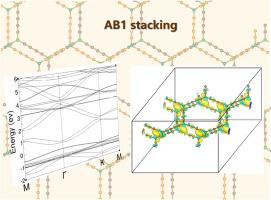Structure and electronic properties of bilayers of boron-graphdiyne
IF 2.4
4区 物理与天体物理
Q3 PHYSICS, CONDENSED MATTER
引用次数: 0
Abstract
Boron-graphdiyne (BGDY) is a planar honeycomb structure in which boron (B) atoms placed at the corners of the hexagons are linked by butadiyne carbon chains. BGDY bilayers with different stacking have been investigated, and the most stable stacking corresponds to a structure in which one of the layers is a bit displaced along a B-B direction with respect to the other. The adhesion energies for the different stackings are rather close, suggesting that all these stackings can be experimentally accessible. The adhesion energy and the equilibrium distance between the two layers result from the balance between weakly attractive dispersion interactions and repulsive Pauli forces which arise when the atoms of the two layers come too close. The calculated electronic band structures reveal the bilayer BGDY is a semiconductor, and that some bands, those with substantial dispersion, split in two due to the layer-layer interaction. The calculated shear stress is anisotropic, and falls in the range of tens of MPa. The different stacking provides a promising way to tailor the size of the BGDY nanopores in applications of these materials as membranes for gas filtration and separation of gas mixtures.

硼-石墨炔双层材料的结构与电子性能
硼-石墨炔(BGDY)是一种平面蜂窝状结构,硼(B)原子位于六边形的角部,由丁烷碳链连接。研究了具有不同堆叠的BGDY双层层,最稳定的堆叠对应于其中一层相对于另一层沿B-B方向有一点移位的结构。不同堆叠层的粘附能相当接近,表明所有这些堆叠层都可以在实验上获得。粘着能和两层间的平衡距离是由于两层原子靠得太近时产生的弱吸引色散相互作用和排斥泡利力之间的平衡。计算的电子能带结构揭示了双层BGDY是一种半导体,并且由于层与层之间的相互作用,一些具有大量色散的能带分裂为两段。计算得到的剪切应力具有各向异性,在几十MPa范围内。不同的堆叠方式为BGDY纳米孔的尺寸定制提供了一种有希望的方法,可以将这些材料用作气体过滤和气体混合物分离的膜。
本文章由计算机程序翻译,如有差异,请以英文原文为准。
求助全文
约1分钟内获得全文
求助全文
来源期刊

Solid State Communications
物理-物理:凝聚态物理
CiteScore
3.40
自引率
4.80%
发文量
287
审稿时长
51 days
期刊介绍:
Solid State Communications is an international medium for the publication of short communications and original research articles on significant developments in condensed matter science, giving scientists immediate access to important, recently completed work. The journal publishes original experimental and theoretical research on the physical and chemical properties of solids and other condensed systems and also on their preparation. The submission of manuscripts reporting research on the basic physics of materials science and devices, as well as of state-of-the-art microstructures and nanostructures, is encouraged.
A coherent quantitative treatment emphasizing new physics is expected rather than a simple accumulation of experimental data. Consistent with these aims, the short communications should be kept concise and short, usually not longer than six printed pages. The number of figures and tables should also be kept to a minimum. Solid State Communications now also welcomes original research articles without length restrictions.
The Fast-Track section of Solid State Communications is the venue for very rapid publication of short communications on significant developments in condensed matter science. The goal is to offer the broad condensed matter community quick and immediate access to publish recently completed papers in research areas that are rapidly evolving and in which there are developments with great potential impact.
 求助内容:
求助内容: 应助结果提醒方式:
应助结果提醒方式:


